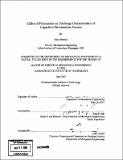Effect of permeation of discharge characteristics of capacitive deionization process
Author(s)
Barman, Ishan
DownloadFull printable version (19.71Mb)
Other Contributors
Massachusetts Institute of Technology. Dept. of Mechanical Engineering.
Advisor
Nam P. Shuh.
Terms of use
Metadata
Show full item recordAbstract
Cost-effective desalination of seawater can be a panacea for the growing freshwater crisis that ranks alongside the problems of shortage of viable energy resources and global warming in terms of its frightening global spread and magnitude. However, the energy guzzling nature of the existing desalination technologies has resulted in very limited relief characterized by a meager 0.3% contribution to the annual water use. In recent years, capacitive deionization (CDI) has been reported to potentially solve some of the crucial issues that have plagued the classical desalination processes. CDI is a low-pressure, non-membrane desalination technology that employs the basic electrochemical principle of adsorbing ions in a capacitive fashion to high surface-area electrodes such that the outgoing stream becomes devoid of the ions that were present in the incoming stream. Although the power efficiency of CDI is nearly an order-of-magnitude superior to the existing processes, it is plagued by the problem of low water recovery ratio. The costs of pumping and pre- and post-treatment of water added to the rising costs of surface water makes maximizing the recovery ratio a priority. Moreover, the throughput of the plant is related to the water recovery ratio. To drastically reduce the problem of low water recovery ratio while still maintaining the sizeable power consumption advantage of the CDI process, we propose a capacitive deionization process with permeating flow discharge (PFD). In PFD, the waste water is permeated through the porous electrodes rather than flowing in-between the electrodes as is the case in the conventional axial flow discharge (AFD) process. (cont.) We hypothesize that the rate of removal of ions from a channel setup is higher for a process that is influenced by solvent drag (PFD) than for one which is diffusion limited (AFD), given the same flow conditions. A table-top setup, designed to simulate the AFD and PFD processes, is used to obtain precise experimental evidence for the ion removal rate for each process. A mathematical model based on unsteady convection-diffusion process for AFD and membrane transport process for PFD is presented. We find that over smaller time scales, permeating flow is much more efficient in removing the ions detached from the electrical double layer in the porous electrode. Based on our experimental observations, we observe that the use of the PFD process, under conventional operational conditions, can cause a discharge time reduction by at least a factor of two. Numerical simulations carried out on the basis of this model are shown to compare favorably with the experimental observations. The model predicts that the reduction in discharge time translates to an increase in water recovery ratio by approximately 30 percent. Moreover, the clear superiority in power efficiency is not surrendered by employing this new scheme.
Description
Thesis (S.M.)--Massachusetts Institute of Technology, Dept. of Mechanical Engineering, 2007. "June 2007." Includes bibliographical references (leaves 88-90).
Date issued
2007Department
Massachusetts Institute of Technology. Department of Mechanical EngineeringPublisher
Massachusetts Institute of Technology
Keywords
Mechanical Engineering.